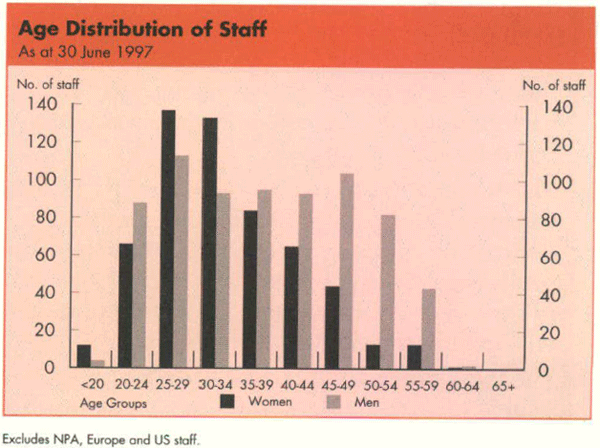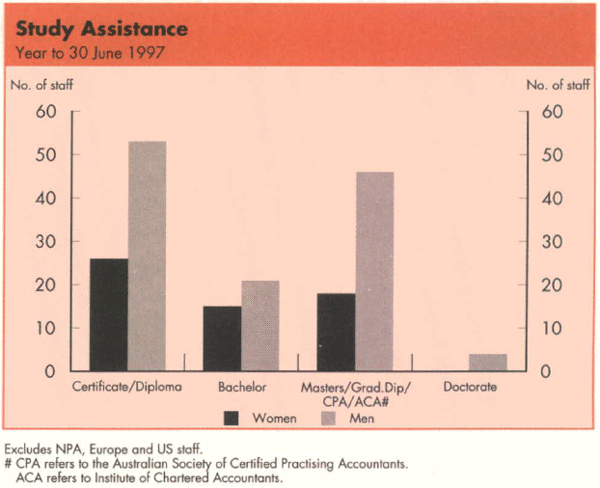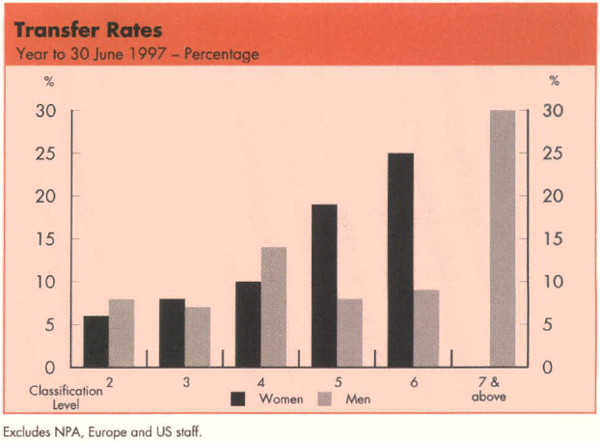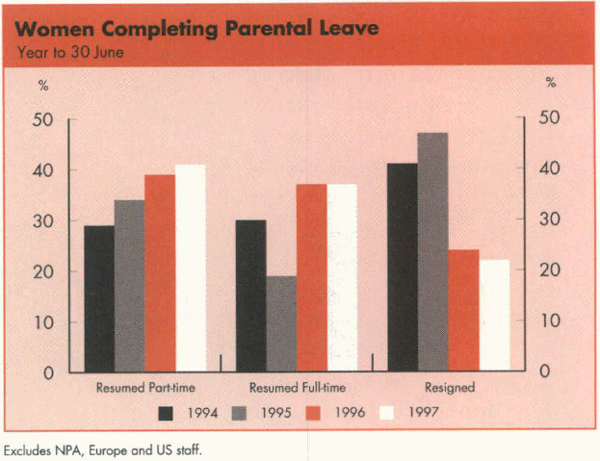Equal Employment Opportunity Annual Report – 1997 Evaluation of the Program
Key Indicators
The data and analysis set out below, together with statistics in Appendices 4 and 5, provide a measure of progress of the four designated EEO groups within the Bank, and a benchmark for appropriate future action. Overall staff numbers declined this year by 219. This was mainly due to the outsourcing of 180 guarding and cleaning positions. Over the decade of the Bank's EEO program total staff numbers have halved.
This year, for the first time, occupational groupings have been analysed using the Australian Standard Classification of Occupations (ASCO) codes from the Australian Bureau of Statistics. These are described more fully in Appendix 3.
Women
-
Women now represent 44% of the Bank's staff; this is similar to last year. When the first EEO statistics were collected in 1987 48% of staff were women. This gradual decline has been largely due to the impact of technology and the resultant loss of clerical jobs. Nevertheless, half of the Bank's staff are still engaged in clerical occupations. Of these 60% are held by women. In 1991, 87% of clerical support positions were filled by women.

-
46% of the Bank's staff are in managerial or professional occupations. 28% of these positions are held by women. Since 1991, the proportion of women at supervisory/management level has continued to increase. The proportion of management positions filled by women (Level 5 and above) has doubled from 8% to 16% over these six years. This year for the first time one of the Bank's functional areas is headed by a woman.

-
Of the 303 staff who left the Bank this year, only 35% were women. The higher turnover rate for men was due to the loss of professional staff and guards. Exit interviews were conducted with 46% of staff resigning. The main reason for resignation for both men and women continues to be concerns about career progression.

- As a group, women are younger than men, but this difference is narrowing. At year end, 50% of total Bank staff are under the age of 35; 61% of women, compared to 42% of men are under the age of 35.
People from Non-English Speaking Backgrounds
- The representation of people from non-English speaking backgrounds (NESB1 and NESB2) has remained similar to last year at 23% of staff overall. In 1991 it was 19%.
- 38% of the staff from non-English speaking backgrounds are in professional/associate professional occupations, which is not significantly different from staff as a whole where 40% are in these occupations.
- Overall, 15% of total Bank staff are in management positions (Level 5 and above). The proportion of management positions filled by staff from non-English speaking backgrounds is 12%.
People with Disabilities and Aboriginal and Torres Strait Islander People
- The representation of Aboriginal and Torres Strait Islander people decreased this year predominantly due to the outsourcing of the cleaning and guarding functions where they were more highly represented.
- 2% of new recruits to the Bank were Aboriginal or Torres Strait Islander people who joined via the Australian Traineeship Scheme.
- The representation of people with disabilities declined slightly from last year. The Bank's reported representation of people with disabilities could be an under-estimate because staff who have acquired disabilities since the 1987 EEO Staff Survey are not identified in the database. A survey will be conducted in the next reporting period to improve the data integrity.
Staff Selection
- Recruitment declined from 194 last year to 113 this year. Factors behind the decline are the outsourcing of the cleaning and guarding functions and the implementation of further Bank restructuring which will reflect in the next reporting period. Of the staff recruited, 35% were women, 16% were from non-English speaking backgrounds, 2% were people with disabilities and 2% were Aboriginal and Torres Strait Islander people.
- The lower representation of women is unusual but reflects that, increasingly, vacancies are arising in professional rather than clerical occupations and in these occupations male applicants predominate. Women represented 34% of applicants for new graduate positions and 17% of the actual intake. The Bank will continue to explore ways to improve the representation of women in graduate recruitment within a merit selection framework.
- The Bank offered 15 places under the Australian Traineeship Program during the year – 8 recruits were women, 1 was a person with a disability and 2 were Aboriginal and Torres Strait Islander people.
- The number of promotions declined again this year. Overall the promotion rate for women was 5% compared to 7% for men. Last year the promotion rate was 8% for both genders. This year there was a greater proportion of promotions in professional occupations where women are not as highly represented.
- During the year around 100 staff selection panels were conducted. Of these 23% were chaired by a woman and 85% had a female member. This is a significant improvement on last year. 50% of staff trained in selection panel procedures during the year were women.
- The Bank continues to encourage applications from EEO groups for non-traditional posts. During the year NPA made its first appointment of a woman to a Project Engineering position.
Career Development & Staff Training
-
Around 60% of staff attended some formal internal training during the year; the rates for all EEO groups were similar. The rates for attendance at external training were lower: around 25% for women compared to 45% for men. Eight women attended Springboard and one senior woman was a mentor for the program. The Bank will continue to monitor training attendance statistics to help ensure that EEO designated groups are given the opportunity to increase their skills.

- Overall 13% of staff received study assistance over the year. 16% of men undertook assisted study compared to 10% of women. The lower representation of women occurs at all classification levels and will be investigated further in the coming year.
-
Four employees, including one woman, had local secondments and a further eight, including one woman, had overseas secondments during the year. Five women attended overseas conferences.

- There were 92 formal internal staff transfers during the year. This is a significant increase from last year. The overall transfer rate was 8% for women and 11% for men. This difference was due to the higher transfer rate at more senior levels where men predominate. The Bank continues to encourage job rotation at all levels for skill development.
Conditions of Employment
-
8% of women and 5% of men took paid parental leave during the year. 54% of women who returned to work from parental leave had been away for up to 12 months. The men were away for an average of 5 paid days. One man took 11 months of unpaid parental leave.

- The number of resignations from parental leave was lower this year. Of those women completing parental leave during the year, 78% returned to work. This is the highest return rate seen over the decade of the Bank's EEO program. More than half returned part-time.
- During the year 35 salaried female staff worked part-time (4 permanent, 4 temporary and 27 contiguous with parental leave).
- As was the case last year around a third of staff took carer's leave during the year. It was used equally by men and women and the average number of days was 2.4.